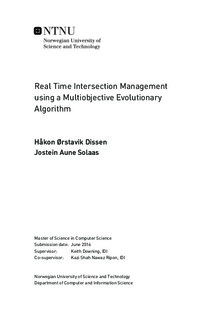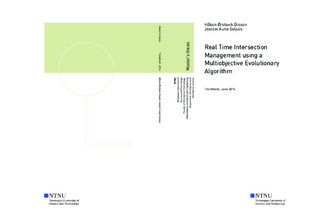| dc.description.abstract | The purpose of this thesis is to investigate the real time use of a Multiobjective Evolutionary Algorithm (MOEA) for intersection management.
Intersection managers (IMs) using deterministic methods for real time intersection management of autonomous vehicles, have been shown to drastically improve traffic flow and congestion over conventional traffic lights. Others, using evolutionary algorithms or other search algorithms, have found methods for approaching the optimal sequencing of vehicles in single states. However, a structured literary review revealed no previous studies on the combination of these methods. In this thesis we used an MOEA to optimise single time steps based on several objectives, and then examined how this translated to behaviour over a continuous time frame.
We have proposed and implemented an IM. In order to experimentally test it a simulator was first adapted for our purposes. Splitting the continuous problem into several discrete time steps introduced the need for two time step parameters. In order to ensure a fair evaluation of the IM, and to study the effects of different time steps, the IM was tested with different values for those parameters. The IM was then tested for specific scenarios, and for continuous operation with different amounts of traffic. To compare the performance of the IM in different settings four performance metrics were used: throughput, mean evacuation time (MET), total loss of kinetic energy and the amount of collisions.
After finding reasonable values for the time step parameters, the IM was shown to route traffic through the intersection with an MET close to the measured optimal value for low and medium amounts of traffic. However, for high amounts of traffic, the complexity of optimising each state becomes too large. As a consequence, the MOEA failed to avoid collisions within the given amount of evaluations. The total kinetic energy lost was found to be dependent on the time step parameters, where smaller values lead to a greater loss of kinetic energy. | |

